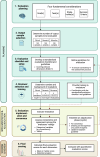A framework for human evaluation of large language models in healthcare derived from literature review
- PMID: 39333376
- PMCID: PMC11437138
- DOI: 10.1038/s41746-024-01258-7
A framework for human evaluation of large language models in healthcare derived from literature review
Abstract
With generative artificial intelligence (GenAI), particularly large language models (LLMs), continuing to make inroads in healthcare, assessing LLMs with human evaluations is essential to assuring safety and effectiveness. This study reviews existing literature on human evaluation methodologies for LLMs in healthcare across various medical specialties and addresses factors such as evaluation dimensions, sample types and sizes, selection, and recruitment of evaluators, frameworks and metrics, evaluation process, and statistical analysis type. Our literature review of 142 studies shows gaps in reliability, generalizability, and applicability of current human evaluation practices. To overcome such significant obstacles to healthcare LLM developments and deployments, we propose QUEST, a comprehensive and practical framework for human evaluation of LLMs covering three phases of workflow: Planning, Implementation and Adjudication, and Scoring and Review. QUEST is designed with five proposed evaluation principles: Quality of Information, Understanding and Reasoning, Expression Style and Persona, Safety and Harm, and Trust and Confidence.
© 2024. The Author(s).
Conflict of interest statement
P.M. has ownership and equity in BrainX, LLC, Y.W. has ownership and equity in BonafideNLP, LLC, and S.V. has ownership and equity in Kvatchii, Ltd., READE.ai, Inc., and ThetaRho, Inc. The other authors declare no competing interests.
Figures









References
-
- Ouyang, L. et al. Training language models to follow instructions with human feedback. Adv. Neural Inf. Process. Syst.35, 27730–27744 (2022).
-
- Touvron, H. et al. Llama 2: open foundation and fine-tuned chat models. Preprint at https://arxiv.org/abs/2307.09288 (2023).
-
- Chari, S. et al. Informing clinical assessment by contextualizing post-hoc explanations of risk prediction models in type-2 diabetes. Artif. Intell. Med.137, 102498 (2023). - PubMed
Grants and funding
LinkOut - more resources
Full Text Sources
Medical

